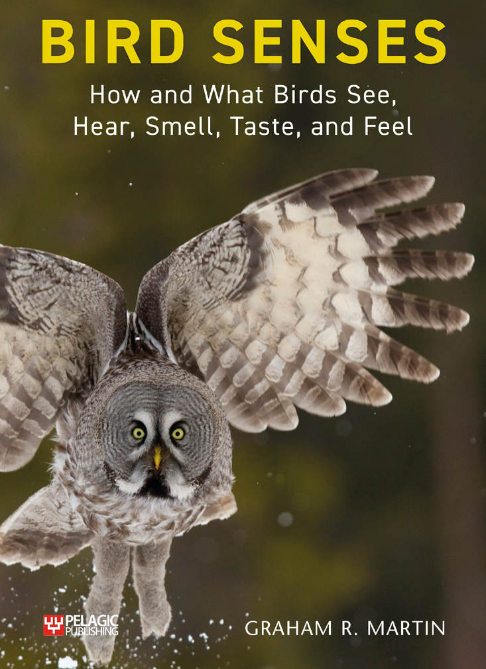
The cover of this book shows a beautiful Great Grey Owl with yellow eyes, barred feathers and trailing legs in flight, with what looks like snow falling off its legs and feet. The blurred background looks like a forest and the book’s title is in yellow with the rest of the writing in white but the Pelagic logo adds a splash of red. At least that’s what I see, and interpret. Is that what it looks like to you? I guess it does because if we didn’t see things very much the same way (literally and metaphorically) there would be an awful lot more misunderstandings in the world. But even if we agree on the colour of the words on the cover, do you see yellow the way I see yellow? How do we know? How can we know?
Now, if a Great Grey Owl were looking at the same cover what would it see? And is its yellow the same as my yellow or your yellow?
This book does what it says on the cover – it tells us how birds sense the environment both in terms of what equipment they have, how the sensory input is processed and the functional significance of sensory perception in birds’ lives. It is fascinating at a technical level and also at a more philosophical level. We learn how and what birds can sense and we get to think more about how our own senses work and what that means about us. Read, at either end of the book, about how well your senses cope with driving a car at night and you might well ease off the accelerator next time.
One of the many, many attractions of birds is that they appear to live in a sensory world quite like our own – one of sight and sound (whereas most of our fellow mammals seem much more ‘interested’ in touch and smell). Birds have patterned and coloured plumages that differ between the sexes, with age and often cyclically through the year and we notice those changes and think we know a lot of what they mean in the lives of birds and so they probably notice them too. And if you disturb a Blackbird, it will fly off making a characteristic call which we will call an alarm call and that call is presumably heard and taken notice of by other Blackbirds and probably other birds (and other creatures too).
This book tells you a lot about the details behind how birds see and hear the world and, yes, it’s quite like the way we do, but the details are fascinating. And not all bird species are the same.
But there is also information on taste, touch and smell and those areas are more difficult for us to find the right words to describe our own perceptions let alone those of other creatures. We generally believe that birds don’t have much of a sense of smell but some do more than others, and some of those do quite a lot. I was really interested to hear what gets up the nose of Great Tits and this whole area is not to be sniffed at.
Birds can taste sweet, sour, salt, bitter and umami just like you and I (although when did you last have a conversation about how umami this meal is?) but they may taste calcium and fat too. One can understand why a taste for calcium might be handy at egg-laying time and maybe those birds on the feeders that move from the fat balls to the mealworms to the sunflower seeds are tasting their way to a balanced diet.
And then there is the whole question of detection of the Earth’s magnetic field (to aid long-distance migration).
I’ve heard the author speak on these matters three times and enjoyed every time. He is a good speaker and talks quite a lot about his research on birds operating in the dark and under water where the senses are challenged to some sort of limit. Those subjects are covered well in these pages too.
The smallest of niggles would be twofold. I sometimes wished that the author would let his hair down a bit and speculate rather more or paint a picture of what he thought we might discover in time. He is very good at explaining what we know for sure but I’d have liked a bit more on what he thought a bird was thinking and sensing as it went about its day. Second, the book ends rather abruptly – I got to the end of page 258 expecting a short chapter rounding things up in some way but found myself in an Appendix. It felt a little as though the author has walked out of the book without a backward glance. Small things in a very impressive and enjoyable read.
There is another similar book on this subject, Bird Sense by Tim Birkhead (published in 2012 and reviewed here) and I flicked through its pages again after reading the current volume. Which is better? They are both very good. If you read and enjoy either you should read the other because you will enjoy that too, with its different writing style and slightly different take on things.
But it’s a bit mean to end a review of this excellent book with a mention of another’s excellent book. Graham Martin’s Bird Senses is a very fine book which is strong on clear explanation. The more we can put ourselves into the minds of other sentient beings, the better we understand ourselves, I suggest.
Bird Senses: how and what birds see, hear, smell, taste, and feel by Graham R. Martin is published by Pelagic.
[registration_form]
Umami? Last week, pasta with home-made mushroom sauce and a grating of parmesan.